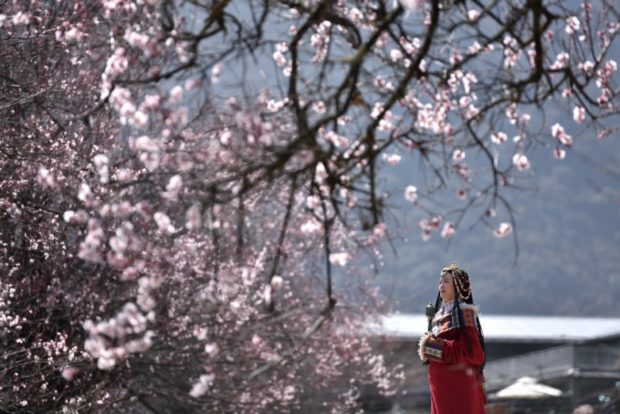
At the ongoing 19th peach blossom festival in the city of Nyingchi, tourists are swarming to different resorts known for their picturesque views of peach flowers with snow-capped mountains in the background. Photo/Xinhua
BEIJING — Peach blossoms in full bloom are not only gracing the spring in Southwest China’s Tibet autonomous region, but also marking a strong start for tourism in the region this year.
At the ongoing 19th peach blossom festival in the city of Nyingchi, tourists are swarming to different resorts known for their picturesque views of peach flowers with snow-capped mountains in the background.
“I have long been fascinated by Nyingchi’s peach blossoms, and finally got a chance this year to come to Nyingchi with my friends,” said Shu Lin, a tourist from Southwest China’s Sichuan province visiting a small village called Kala.
The village has been the venue for the opening ceremony of the festival for many years, as it has a vast number of peach trees, mostly wild, across its mountainous terrain. Some of its peach trees are more than 100 years old.
“This is really like a fairyland on earth. Snowy mountains, blue skies and peach blossoms complement one another with a rich spectrum of colors,” said Shu.
Last year, the event welcomed far fewer visitors due to COVID-19 prevention and control measures. Nyingchi saw its number of incoming tourists drop about 70 percent in the first half of 2020.
This year, however, the tourists are back.
The opening ceremony was held on Saturday, and Nyingchi received 97,200 visitors, up 35.75 percent from pre-pandemic levels in 2019. Its tourism revenue has surged 32.6 percent from 2019 to 19.26 million yuan (about $2.9 million), according to the city’s tourism development bureau.
At the ongoing 19th peach blossom festival in the city of Nyingchi, tourists are swarming to different resorts known for their picturesque views of peach flowers with snow-capped mountains in the background. Photo/Xinhua
In the first three days of the festival, the number of tourists rose 32.59 percent from 2019, while tourism revenue soared 96.83 percent from the same year, the bureau said.
Zhang Rundong, the bureau’s deputy Party chief, said the city has held a series of online and offline promotional activities to make the peach blossom festival “a highlight of tourism in Nyingchi and Tibet.”
Nyingchi is about 400 km away from Lhasa, the capital of Tibet. Translated from Tibetan, it means “the throne of the sun.” It is about 3,100 meters above sea level.
That may sound high, but Nyingchi is one of Tibet’s lowest areas. An upside of this is that visitors rarely suffer altitude sickness, so it is a great entry location for those looking to explore Tibet.
At the ongoing 19th peach blossom festival in the city of Nyingchi, tourists are swarming to different resorts known for their picturesque views of peach flowers with snow-capped mountains in the background. Photo/Xinhua
“The festival will serve as a strong start for the recovery and development of the tourism industry here this year,” said Zhang.
Last year, due to COVID-19, the city’s total tourism revenue was approximately 4 billion yuan. This year, it is expected to reach 8.5 billion yuan, according to Zhang.
Clear waters and lush mountains are invaluable assets. Over the past few years, the value of the area’s natural resources has gained notice. People in the city used to fell trees, but now they plant them to make the place more beautiful and attractive to visitors.
Zhang said the city plants trees every year now. “Part of the tree planting efforts were government-led, and people also took the initiative.”
Despite the strong negative impact of COVID-19, Tibet has seen fast tourism recovery, with Nyingchi taking the lead in the region, he added.
“We are confident that the city will more than double last year’s tourism revenue this year,” Zhang said.